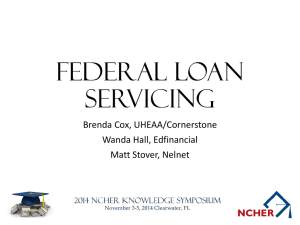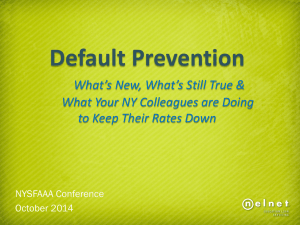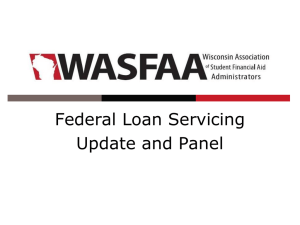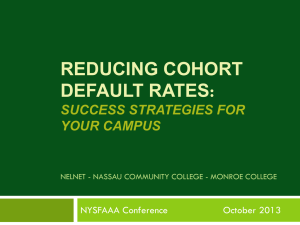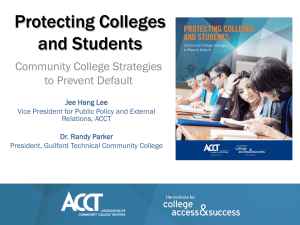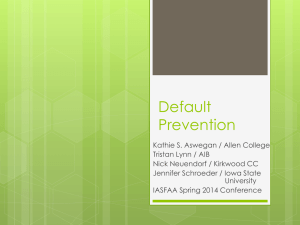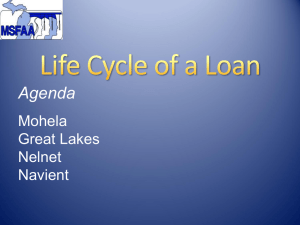Loan Servicing & Loan Default
advertisement
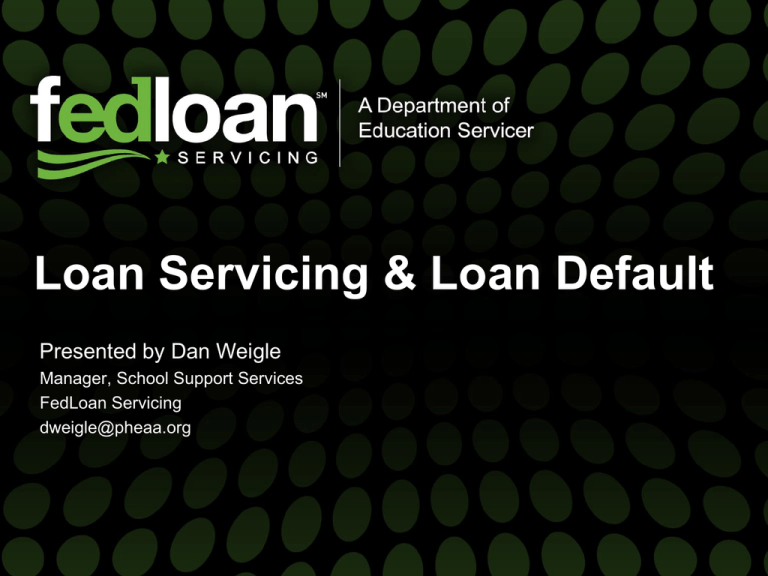
Loan Servicing & Loan Default Presented by Dan Weigle Manager, School Support Services FedLoan Servicing dweigle@pheaa.org Agenda • • • • • 2 Role of the servicer Communication milestones Servicer support activities Default statistics School involvement Federal Loan Servicers Comply with legislative regulatory requirements and provide unique services to borrowers and schools 3 For Borrowers: For Schools: • Educate and inform borrowers regarding the tools and options available to assist in the management of their student loans • Offer multiple repayment options tailored to borrower preferences (i.e. online payments, ACH, check, etc.) • Provide self-service tools for borrowers and options to receive bills and/or correspondence electronically • Offer dedicated services to schools • Help schools to manage delinquency activities and cohort default rates “TIVAS” Title IV Additional Servicers “TIVAS” An acronym used by FSA which stands for the Title IV Additional Servicers. In communications with schools, borrowers, and the financial aid community, FSA uses the term “federal loan servicers.” 4 Federal Loan Servicers - TIVAS COD LDE • • • • • Origination Disbursement Loan Allocation Servicer Assignment Customer Service COD LDE : Loan Distribution Engine: interface to assign loans to the federal loan servicers. “Booked” Loan: occurs when the COD system accepts an origination record; links p-note to the record and accepts actual disbursement. The federal loan servicer is assigned upon “booking” of loan. 5 Servicers S E R V I C I N G Direct Loan Servicing Center (ACS) FedLoan Servicing (PHEAA) Great Lakes Educational Loan Services, Inc. Nelnet Sallie Mae Not-For-Profit Servicers “Not-For-Profit awarded federal loan servicing contracts under the HCERA/SAFRA Not-For-Profit (NFP) Servicer Program solicitation. 6 Not-For-Profit Servicers 7 • Federal loan servicing contracts awarded under the HCERA/SAFRA Not-For-Profit (NFP) Servicer Program solicitation • Federal loan servicer team will continue to expand as the loan portfolio grows • Whether individual or team award, borrowers will know and face one servicer Not-For-Profit Servicers 8 NFP Servicer NSLDS Name NSLDS Code Aspire Resources Inc. DEPT OF ED/ASPIRE RESOURCES INC.-ISL 503 COSTEP DEPT OF ED/COSTEP 510 CornerStone DEPT OF ED/CORNERSTONE-UHEAA 502 EDGEucation Loans DEPT OF ED/EDGEUCATION LOANS 509 EdManage DEPT OF ED/EDMANAGE 505 ESA/Edfinancial DEPT OF ED/ESA-EDFINANCIAL 501 Granite State – GSMR DEPT OF ED/GRANITE STATE-GSMR-NH 504 KSA Servicing (Kentucky) DEPT OF ED/KSA SERVICING 508 MOHELA DEPT OF ED/MOHELA 500 OSLA Servicing DEPT OF ED/OSLA SERVICING 506 VSAC Federal Loans DEPT OF ED/VSAC SERVICING 511 Measuring Performance Borrower Satisfaction School Satisfaction FSA and Partner Satisfaction Servicer Performance Score Default Prevention Measures 9 9 Allocation Methodology • • • • • • 10 Allocations are based on rankings Survey results Default statistics Most points for first place One point for last place Percent of new loans = percent of points 10 Due Diligence Requirements Stage Required Action Up to 8 calls 5 letters 5 emails 1 Communication Attempt Mid 121-240 Up to 8 calls 2 reference calls Up to 3 letters 4 emails 1 Communication Attempt Late 241-360 Up to 6 calls 2 letters 5 emails 1 Communication Attempt Early 1-120 11 FedLoan Servicing Action Servicer Role - Loan Lifecycle On-Boarding Grace In-School Prepare for Successful Transition to Repayment Early intervention Repayment options Repay plan modeling Reminder to set up acct “We’re here to help” Establish Customer Relationship Contact information Online acct set-up Tools available “We’re here to help” Maintain Contact Obligation reminders Financial Literacy NSLDS Update/exchange Answer questions “We’re here to help” 12 Communication Channels USPS Email Phone Web Social media Text Tools Available Financial Literacy Self service options Numerous payment options Repayment plan modeling Call center agents Delinquent Repayment Repayment Focus on Healthy Repayment Predictive modeling/segmentation Reminders of repayment solutions Proactive skip-tracing Increasing intensity of contact “We’re here to help” Ensure Successful Transition to Repayment Early intervention assistance Repayment options Promote auto-debit Repayment tools available Billing reminders Transaction updates Outreach to at risk borrowers Repayment counseling Self-service options “We’re here to help” Services Offered School default management assistance School access to borrower acct info School call center School webinars/relevant servicing info Communication Milestones FedLoan Servicing In School to In Grace Communications Welcome Letter & Email / Privacy Notice Enrollment Change Confirmation 13 Disbursement Notification Email Outstanding Interest Email Loan Summary Email Interest Bill* * To receive an Interest bill while in school, the borrower must contact us. Note: This is the FedLoan Servicing communication timeline. While other timelines may vary, most servicers will have similar milestones. Communication Milestones FedLoan Servicing In Grace to In Repayment Communications Entering Grace Email Entering Repayment Email 14 3-Month Grace Email Interest Notice Installment Bill Repayment Obligation/ Schedule Disclosure Statement Servicer Support Activities Federal Loan Servicers: • Provide outbound targeted calling campaigns along with inbound call center representatives to help borrowers become current • Utilize electronic communication methods, such as e-mail, to keep borrowers informed about account status • Work with schools to obtain current available contact information - Utilize a variety of tools to get the most current data to contact borrowers (skip tracing on delinquent accounts) • Work in partnership with the school community to assist borrowers in the later states of delinquency 15 Servicer Support Activities Cure Rates • Over 95% of delinquent contacts result in a cure within 30 days of contact • 1/3 of borrowers that hit 30 days delinquent cure before 60 days delinquent • 87% of borrowers that hit 270 Days delinquent continue to fall delinquent 16 Default Statistics FedLoan Servicing 3 year 2011 Cohort Defaults SCHOOL TYPE PROGRAM LENGTH # BRWR DEFAULT # DEFAULT BRWR WITHDREW % PRIVATE SCHOOL PRIVATE SCHOOL PROPRIETARY SCHOOL PROPRIETARY SCHOOL PUBLIC SCHOOL PUBLIC SCHOOL 2 YEAR 4 YEAR 2 YEAR 4 YEAR 2 YEAR 4 YEAR 528 10,899 13,050 29,321 30,906 19,911 332 8,092 9,004 25,456 23,488 15,393 63% 74% 69% 87% 76% 77% FedLoan Servicing 3 year 2010 Cohort Defaults 17 SCHOOL TYPE PROGRAM LENGTH # BRWR DEFAULT # DEFAULT BRWR WITHDREW % PRIVATE SCHOOL PRIVATE SCHOOL PROPRIETARY SCHOOL PROPRIETARY SCHOOL PUBLIC SCHOOL PUBLIC SCHOOL 2 YEAR 4 YEAR 2 YEAR 4 YEAR 2 YEAR 4 YEAR 518 10,318 6862 21,698 21,859 16,574 205 5,104 2,143 13,564 10,310 8,306 40% 49% 31% 63% 47% 50% Strategies for Targeting At-Risk Borrowers Financial Aid Awareness Counseling Target Groups 18 Understand Income Driven Repayment Plans Sign-up for Account Access NSLDS Reports School Portfolio Report (SCHPR2) • The School Portfolio Report (SCHPR2) provides school users with information about all Direct Loan and/or FFEL program loans for a specified school Delinquent Borrower Report (DELQ01) • The Delinquent Borrower Report (DELQ01) provides school users a report of borrowers who have been reported as delinquent in making loan payments to one of the federal loan servicers Use the NSLDS Delinquent Borrower Report to produce letters to delinquent borrowers who have loans serviced by any federal servicer. 19 19 Engaging At-Risk Borrowers In School Target at-risk borrowers with early/extra exit loan counseling, financial literacy training, and collect additional contact Information. Which at-risk borrowers? • • • 20 Students on academic probation Students who express intention to withdraw Students currently enrolled in programs producing a disproportionate number of defaulters Engaging At-Risk Borrowers In Grace Steps to take: • • • • • • • 21 Validate contact information Re-enrollment assistance Transfer assistance Prepare borrower for repayment Provide employment counseling and search preparation Job placement assistance Assist in establishing a relationship with servicer Engaging At-Risk Borrowers In Repayment Reach out to at-risk borrowers and facilitate the critical contact with the loan servicer to prevent default. • Early Stage Delinquency: Target borrowers 30-60 days delinquent • Mid Stage Delinquency: Target borrowers 60-270 days delinquent • Late Stage Delinquency : Target borrowers 270+ days delinquent 22 Are You Making an Impact? Categorize your efforts, track your success, and make adjustments. Establish an action plan and follow the students targeted to determine their success. Track Your Efforts High-Risk Program of Study - Total Students (90) 23 Sample Size Target Attendance Effort Made in-school payment Enrolled in autopayments Non-delinquent 50 23 (45%) Explained Income Driven Repayment Plans 5 (10%) 15 (30%) 45 (90%) 40 30 (75%) Completed FACT w/ Exit Counseling 2 (5%) 15 (38%) 30 (75%) Late-Stage Delinquency Students - Total Students (100) Sample Size Effort Target Responders/ Contacts Responded to effort Resolved delinquency thru payment Resolved delinquency thru other means 50 Email 13 (25%) 15 (30%) 7 (47%) 8 (53%) 50 Phone Call 25 (50%) 30 (60%) 10 (33%) 20 (67%) How to Help Defaulters When federal student loans default, borrowers are provided with opportunities to clear their credit history. Borrowers with defaulted student loans can regain eligibility for federal student aid and return to good standing with their loan servicer. What needs to happen: • • • • 24 To regain Title IV eligibility a student must make at least six voluntary ontime payments for six consecutive months. To rehabilitate a defaulted loan a student must make at least nine full voluntary payments within 20 days of their monthly due date over a 10 month period. Consolidation is an option to bring the account current, but does not remove the default record from a student's credit report. Pay the loan in full. How to Help Defaulters Benefits of rehabilitating defaulted loans: • Students will regain all benefits such as deferments, forbearance, loan forgiveness, and repayment options. • Regain eligibility for federal student aid. • Default status will be removed from credit report. • Wage garnishment and withholding of income tax return will cease. Who to contact: • Debt Management Collection Services (DMCS) – • The U.S. Department of Education's Federal Student Aid Ombudsman – – 25 1-800-621-3115 1-877-557-2575 fsaombudsmanoffice@ed.gov Resources Cohort Default Rate • The Cohort Default Rate Guide http://www.ifap.ed.gov/DefaultManagement/guide/CDRGuideMasterVersion.html Delinquency and Default Management • Electronic Announcement – Delinquency Prevention Activities and Webinars -- Monitor IFAP for updates http://www.ifap.ed.gov/eannouncements/071411DefaultPreventionResourceInfoSite.html Assessments • FSA Assessments http://www.ifap.ed.gov/qahome/qaassessments/defaultmanagement.html Presentations • Federal Loan Servicer Panel Discussion http://ifap.ed.gov/presentations/2012FSAConference.html 26 26 Questions Dan Weigle Manager, School Support Services FedLoan Servicing 717.720.2955 dweigle@pheaa.org 27 27


